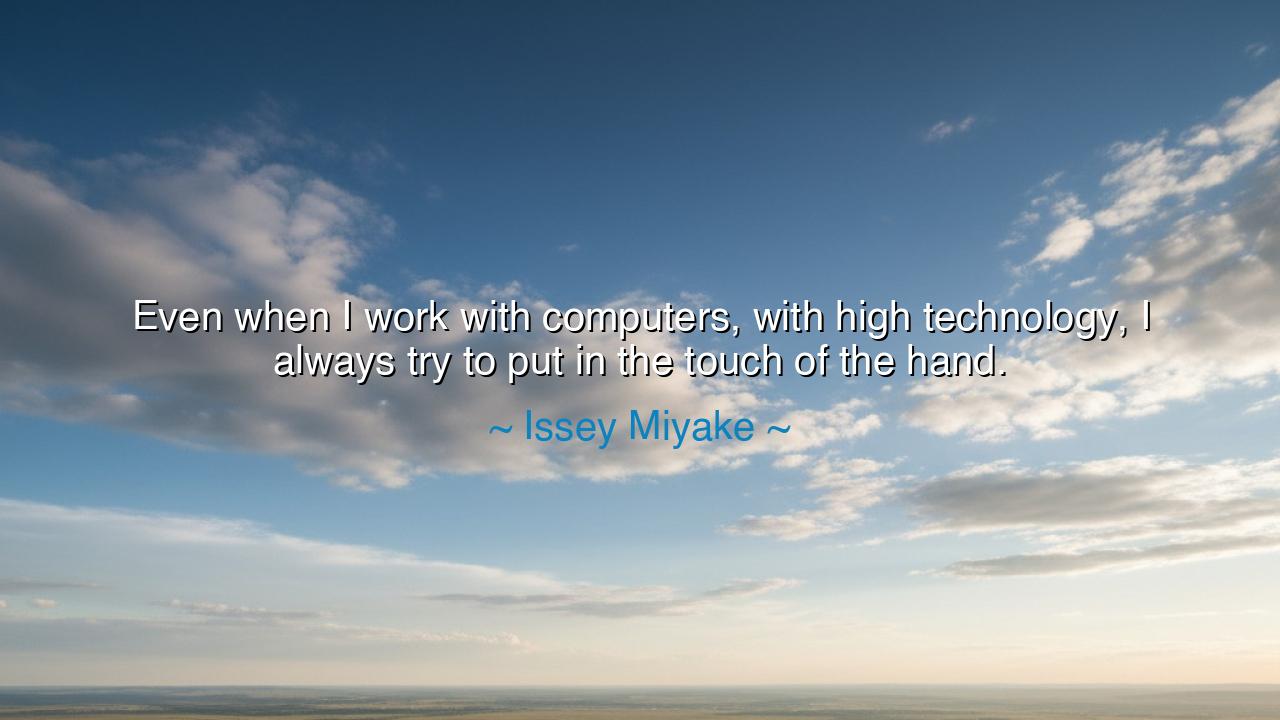
Even when I work with computers, with high technology, I always
Even when I work with computers, with high technology, I always try to put in the touch of the hand.






In the age of machines and automation, when the world rushes towards greater efficiency and the cold, precise calculations of technology, Issey Miyake’s words stand as a profound reminder of the human touch. “Even when I work with computers, with high technology, I always try to put in the touch of the hand.” In these words, Miyake speaks of a truth that transcends the very tools we use to shape the world. He reminds us that, despite the relentless march of progress and innovation, there remains something invaluable about the human element—a personal connection, a sense of soul that technology alone cannot provide.
The touch of the hand, as Miyake refers to it, is more than a physical action—it is a symbol of human craftsmanship, of the artistic spirit that infuses even the most mechanized processes with life. In an era where we are surrounded by machines and digital interfaces, it is easy to forget that the greatest achievements of human civilization were never solely the result of cold calculations and abstract logic. Whether in the realm of art, architecture, or technology, it is the human touch—the creative vision of an individual—that breathes soul into our creations. Miyake’s commitment to infusing technology with humanity serves as a call to remember the value of artistry in every aspect of life.
This concept of blending human touch with technology is not a new one. In the ancient traditions, the greatest works of craftsmanship were always a union of mind and hand. Daedalus, the legendary craftsman of Greek mythology, was known for his incredible ability to create lifelike statues and intricate designs that appeared to breathe with life. His creations were not mere objects; they were expressions of his vision, his humanity, and his soul. The human hand, guided by the human spirit, had the power to imbue even inanimate objects with meaning and purpose. Miyake, much like Daedalus, seeks to create not just functional machines or garments but objects that speak to the deeper human experience.
One of the most powerful examples of this is Miyake’s own fashion designs, where he merged the worlds of art and technology. In his work, the handmade is woven together with modern techniques to create clothing that is both innovative and intimately human. His pieces are not mere products but expressions of creativity, showing that even in the age of high-tech materials and advanced manufacturing, there is a place for the sensitivity of the hand. Just as Leonardo da Vinci used his own hands to draw the most intricate of sketches and design the most innovative inventions, so too does Miyake use his creativity to ensure that his technological advancements never lose their connection to the human soul.
In a world dominated by the cold precision of machines, Miyake’s insistence on adding the touch of the hand serves as a reminder that the heart of human creativity lies not in the precision of technology, but in the imperfect beauty that arises when the human spirit interacts with the material world. The hand represents more than just the ability to create; it represents the human essence that gives life and meaning to everything we make. It is the imperfections, the subtle flaws, the personal touch that makes a creation unique, and it is this uniqueness that speaks to our shared humanity.
Consider the story of Michelangelo, the Renaissance master, who shaped marble with his own hands, transforming cold stone into lifelike figures. In his famous sculpture of David, Michelangelo did not just carve a figure; he breathed life into it. The flaws of the stone were not hidden but embraced. This was not just craftsmanship; this was the expression of the soul through the hand. Miyake’s words remind us that the human touch is not only about the physical act of creation but about infusing meaning and soul into what we produce. Whether in fashion, art, or technology, it is the human spirit that gives our work its lasting significance.
Lesson for the ages:
In every endeavor, whether in art, work, or life, always seek to bring the touch of the hand—the human element. The greatest creations are not those made in isolation from the human experience, but those that connect us to our deeper selves. As we advance in technology and progress, let us never forget the value of the human spirit, for it is the soul of humanity that turns mere objects into expressions of life.
Practical Action:
In your daily work, whether it is creating art, developing technology, or pursuing your own passions, seek to add the touch of the hand. Infuse your work with creativity, intention, and sensitivity. Technology and machines are tools, but the human spirit is the true driver of greatness. Whether you are a designer, a scientist, or an entrepreneur, always remember that it is the human touch—the soul behind the work—that gives it true meaning. In this, you will find not only success, but also fulfillment and purpose in your craft.






AAdministratorAdministrator
Welcome, honored guests. Please leave a comment, we will respond soon